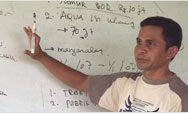 |
 |
|
 |
 |
|
 |
 |
 |
| USAID Information:
External Links:
|
|
 |
 |
|
 |
 |
|
USAID Assistance to Pakistan
October 29, 2008
Fact Sheet #1, Fiscal Year (FY) 2009 (PDF, 51kb)
Background and Key Developments
- On October 29 at 0400 hours local time, a magnitude 6.4 earthquake struck 80 miles northwest of Quetta, in the
Balochistan Province of southwestern Pakistan, according to the U.S. Geological Survey (USGS). To date, USGS
reports that the earthquake has been followed by at least 11 aftershocks measuring greater than magnitude 4.0,
including one aftershock of 6.4 magnitude.
- The earthquake primarily affected Ziarat and Pishin districts in Balochistan Province, where the Government of
Pakistan (GOP) National Disaster Management Authority (NDMA) reports that more than 2,000 houses were
destroyed as a result of the earthquake.
- On October 31, U.S. Ambassador Anne W. Patterson issued a request for USAID/OFDA assistance due to the effects
of the earthquake. In response, USAID/OFDA allocated an initial $1 million in assistance for earthquake-affected
populations.
- In addition, USAID/OFDA deployed a four-person USAID Disaster Assistance Response Team (USAID/DART) to
target USAID/OFDA funding and facilitate U.S. Government (USG) humanitarian assistance. Three members of the
USAID/DART are already in-country working with USAID/Pakistan, the U.S. Embassy in Islamabad, and
humanitarian partners. One additional USAID/DART member is scheduled to arrive on November 5.
- On November 2, USAID/OFDA allocated an additional $1.5 million for the relief effort in Pakistan, bringing the total
USAID/OFDA contribution in response to the earthquake to $2.5 million. Of this funding, USAID/OFDA is
committing $1 million to the International Committee of the Red Cross (ICRC) for the provision of emergency
assistance, including emergency health care, shelter, relief commodities, and water and sanitation interventions, for
earthquake-affected populations.
ESTIMATED NUMBERS AT A GLANCE
| Total Dead |
166 |
NDMA – November 1, 2008 |
| Total Injured |
500 |
IFRC1 – November 1, 2008 |
| Internally Displaced Persons |
17,500 households |
IFRC – November 1, 2008 |
|
FY 2009 HUMANITARIAN FUNDING ALLOCATED TO DATE
| USAID/OFDA Assistance to Pakistan |
$2,500,000 |
| Total USAID Humanitarian Assistance to Pakistan |
$2,500,000 |
|
|
|
|
Current Situation
- On November 1, IFRC reported that current GOP figures and preliminary field assessments indicate the earthquake
killed more than 160 individuals and injured approximately 500 others. Reports from media and civil organizations
estimate that the death toll is 300 or more persons, with up to 1,000 individuals injured. ICRC has noted that the
number of reported deaths may increase significantly as remote areas are reached.
- According to IFRC, preliminary assessments indicate that the earthquake displaced an estimated 17,500 families in
Ziarat and Pashin. Humanitarian organizations expect more comprehensive estimates of affected and displaced
populations as information from ongoing rapid assessments becomes available.
Humanitarian Needs
- The U.N. Office for the Coordination of Humanitarian Affairs (OCHA), ICRC, and other humanitarian organizations
have confirmed an immediate need for emergency shelter for populations displaced by the earthquake. According to
OCHA, many people are sleeping outdoors without adequate shelter for fear of aftershocks. ICRC representatives
have noted that transitional shelter will be a high priority once emergency needs are met. In addition, OCHA has
reported urgent needs for food and relief commodities among displaced populations living in spontaneous settlements.
- Since October 30, U.N. agencies have conducted a joint rapid assessment of affected areas in Ziarat and Pishin
districts. According to the U.N. World Health Organization (WHO), preliminary assessment results indicate that the
earthquake damaged 10 of the 38 health facilities in Ziarat District, with three basic health units completely destroyed.
In Pishin District, three of the 57 facilities were partially damaged. WHO reported that all hospitals in Quetta District
are functional.
GOP Response
- The NDMA is currently not requesting, but will accept, international assistance to respond to the effects of the
earthquake. On October 31, OCHA reported that the chief minister of Balochistan Province had issued a press release
on October 30 requesting assistance for emergency interventions, as well as rehabilitation and reconstruction efforts.
- According to the Inter-Services Public Relations Directorate of the Pakistan Armed Forces (PAF), the PAF has
established relief centers in Gogai, Ahmadon, Malazai, Kawas, Verchum, Wam Kotli villages and in Quetta.
- As of November 1, the PAF had flown 30 sorties and used 60 trucks to transport relief goods to affected areas,
including a total of 5,000 non-winterized tents, 116,600 blankets and quilts, 12,000 sleeping mats, and 1,472 sleeping
bags, according to the NDMA.
Humanitarian Response
- On October 30, the Pakistan Red Crescent Society provincial branch in Quetta dispatched 13 trucks transporting
emergency relief supplies, including 725 tents, 1,200 plastic sheets, 560 coal stoves, and nearly 2,800 blankets and
quilts, to affected areas.
- On October 31, one inter-agency emergency health kit and five mini emergency health kits arrived in Quetta. The kits
will provide health supplies for a total of 20,000 people for three months. Two U.N. trauma kits are scheduled to
arrive in Quetta from Dubai on November 4.
- On November 3, the first trucks transporting USAID-funded plastic sheeting for the construction of temporary shelters
arrived in Quetta. The plastic sheeting will be distributed to affected populations in Ziarat District in consultation
with GOP authorities, and additional USAID-funded plastic sheeting is scheduled for distribution in the next three
days.
- On November 3, the U.N. World Food Program (WFP) began food distributions from warehouses in Quetta and
Peshawar, in coordination with other U.N. agencies and the GOP. WFP plans to initially provide 700 metric tons of
dry food rations to the affected populations. The distributions will include wheat flour, pulses, edible oil, and salt to
meet the needs of 20,000 people for two months.
- The U.N. Children�s Fund (UNICEF), in coordination with the GOP Public Health Engineering Department, is
planning projects to ensure the availability of safe drinking water for 12,000 earthquake-affected individuals in Ziarat
District, including the provision of five 5,000-liter water bladders and two 10,000-liter water bladders, deployment of
water tankers, and repair of a water supply scheme in Kawash village, Ziarat District. In addition, UNICEF has begun
mobilizing plastic sheets and hygiene kits for 5,000 families, as well as preparing for construction of 500 latrines.
USAID HUMANITARIAN ASSISTANCE
- On October 31, U.S. Ambassador Anne W. Patterson requested USAID/OFDA assistance due to the effects of the
earthquake. In response, USAID/OFDA allocated an initial $1 million in assistance for earthquake-affected
populations.
- In addition, USAID/OFDA deployed a four-person USAID/DART to target USAID/OFDA funding and facilitate
USG humanitarian assistance. Three members of the USAID/DART are already in-country working with
USAID/Pakistan, the U.S. Embassy in Islamabad, and humanitarian partners. One additional USAID/DART member
scheduled to arrive on November 5.
- On November 2, USAID/OFDA allocated an additional $1.5 million for the relief effort in Pakistan, bringing the total
USAID/OFDA contribution in response to the earthquake to $2.5 million. Of this funding, USAID/OFDA is
committing $1 million to ICRC for the provision of emergency assistance, including emergency health care, shelter,
relief commodities, and water and sanitation interventions, for earthquake-affected populations.
For detailed information on U.S. Government humanitarian assistance to Pakistan, click here
Back to Top ^
|


